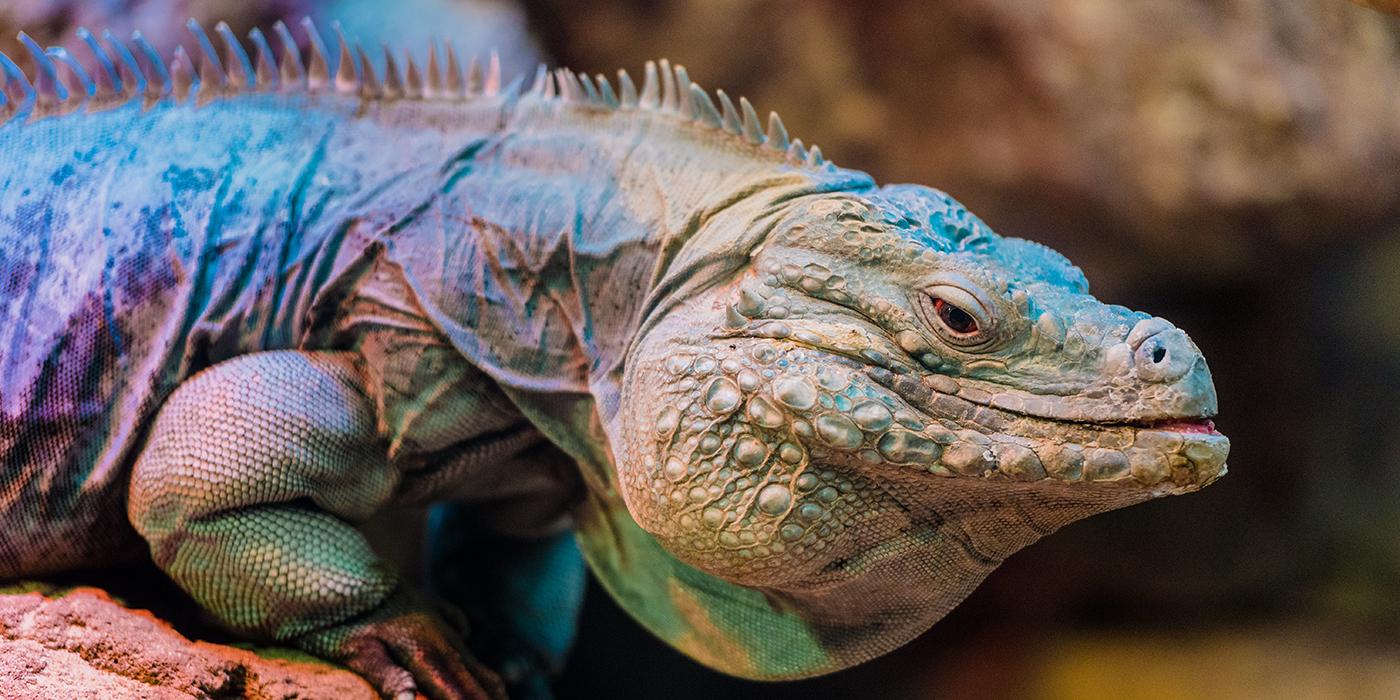Physical Description
The Grand Cayman blue iguana's skin is dusky-blue to gray with cross bands that are often barely visible. Its coloration provides great camouflage among the rocks and scrub it inhabits. During the mating season, these lizards become a brighter blue.
Size
This species of “rock iguana” can exceed 5 feet (1.5 meters) in length (nose to tail tip) and can weigh more than 25 pounds (11 kilograms). These heavy-bodied lizards are the Grand Cayman’s largest native land vertebrate.
Native Habitat
Cayman Island blue iguanas are found only on Grand Cayman Island. They prefer dry, rocky forests in coastal areas, which may contain cactus and other thorny plants. These lizards may also be found in scrub woodlands, semi-deciduous forests and dry-to-subtropical, moist forests. Iguanas are rather adaptable and may be found in man-modified habitats, as well.
Lifespan
Blue iguanas appear to be a long-lived species, generally surviving for 25 to 40 years in the wild. One male in human care in the U.S. lived to be at least 69 years old.
Food/Eating Habits
These primarily herbivorous lizards eat mostly leaves and stems, as well as fruits and flowers. They have occasionally been observed feeding on fungi, insects, soil and excrement.
At the Smithsonian’s National Zoo, these lizards eat leafy green vegetables, carrots, sweet potatoes and herbivorous lizard pellets.
Sleep Habits
Reproduction and Development
Grand Cayman iguanas are sexually mature between 4 and 9 years of age. The breeding season takes place from April to June and seems to be triggered by the onset of the spring season. After copulation, the female becomes very territorial and aggressive.
She digs a nest cavity at least 1 foot deep in the sand and lays heir eggs between late June and August. After depositing up to 20 eggs, she covers them with soil. The eggs incubate at a temperature of about 86 to 91 degrees Fahrenheit (30 to 33 degrees Celsius), and the babies hatch 60 to 90 days later. The hatchlings are vulnerable to predation and have a high mortality rate.
Conservation Efforts
Once listed as critically endangered, Grand Cayman blue iguanas were reassessed in 2012 by the IUCN and downlisted to endangered.
Predation from feral animals poses a large threat to these iguanas, and free-roaming dogs and cats have also been known to hunt and kill both juveniles and adults. Norway rats pose an additional threat to juveniles and hatchlings. As human populations increase, so do the populations of these predators.
Protection under CITES Appendix I has kept blue iguanas from the international pet trade, but they are sometimes illegally collected by locals. Additionally, habitat loss has become a problem as land is converted for agriculture. While iguanas are adaptable, the loss of forests converted for agricultural lands means less food and also brings these lizards in conflict with farmers.
The National Trust for the Cayman Islands has some protected land, but there is a need for more land protection in areas suitable for blue iguanas. The Blue Iguana Recovery Program has also successfully established a head-start program, which releases captive-bred blue iguanas into protected areas once they reach a size where they are less likely to be killed by predators. Furthermore, the Grand Cayman blue iguana is a popular ecotourism attraction, which could help bolster the desire to preserve this species.
Help this Species
Practice ecotourism by being an advocate for the environment when you’re on vacation. During your travels, support, visit or volunteer with organizations that protect wildlife. Shop smart too! Avoid buying products made from animals, which could support poaching and the illegal wildlife trade.
Choose your pets wisely, and do your research before bringing an animal home. Exotic animals don’t always make great pets. Many require special care and live for a long time. Tropical reptiles and small mammals are often traded internationally and may be victims of the illegal pet trade. Never release animals that have been kept as pets into the wild.
Smithsonian's National Zoo and Conservation Biology Institute. (n.d.). Grand Cayman blue iguana. Retrieved January 17, 2026, from https://nationalzoo.si.edu/animals/grand-cayman-blue-iguana
Animal News





